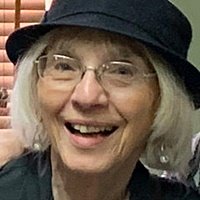THE CAT WHO ADOPTED ME
(SORT OF)
By Adelaide Shaw
I saw him slinking through the neighborhood, foraging in trash cans, sleeping under cars. Black as a jungle panther but lacking the heft and fierceness of his ancestors, he kept his distance and ran into the shadows with the slightest movement, be it from a person, a dog or a blowing leaf. He was totally feral.
My days were full, caring for three children, ages five, four and two and trying to keep our two-bedroom apartment from turning into an Unsafe To Enter Zone. I didn’t have time to spend taming a feral cat. A feral kitten may be tamed and adopted, but rarely an adult cat. So why was I, when the children were asleep and dinner dishes needing to be washed and acquiring a cement like crust, sitting on the back stoop waiting for Panther? Because I love cats. I love their cute faces, their softness and purring motor they turn on when petted. Cats, contrary to the non-cat lovers’ bible, are affectionate and show it with head butting, body rubbing and snuggling. I love that.
I didn’t know if Panther was anywhere near my stoop, but I placed two metals bowls about five feet away, one with water and the other with tuna, meant for the next day’s tuna casserole. Was I taking food away from my children? No! They wouldn’t eat tuna even with chocolate sprinkles. Actually, neither would I.
There was no spotting of Panther. After an hour, I left the tuna and went inside to do a little purring with my husband.
In the morning I found the empty tuna bowl by my neighbor’s stoop. I never did find the water bowl, just a small puddle of water. Maybe Panther ate the tuna or another cat, dog or racoon, or a rather hungry child who liked tuna ate it.
That day I bought more tuna for my famous casserole, several cans of cat food and a bag of cat kibble. I stashed the kibble where curious children couldn’t find it and think it was a new variety of the cereal they liked. I didn’t think the kibble would harm them, but they could like it. Then, what would I do with the supersize box of crunchy munchies shaped like animals?
The next night I repeated my routine with the bowls of food and water, with one addition. I sprinkled a line of kibble from my neighbor’s stoop to the bowls. I waited longer for Panther to appear. He did, nibbling his way to the bowls. He looked at me. I looked at him. Two statues. Hunger gave sway to fear.
Each night I placed the bowls a little closer to me. By the end of the week he was close enough for me to reach out and touch him. He checked me out between each bite. A look of fear and wariness. He was still feral.
My husband during my nocturnal rendezvouses with this short, dark and mysterious stranger was with his own lover of the night—his doctoral dissertation. Both of us on a mission.
I began to speak to Panther, softly without moving. He stopped checking me out after each bite, licked the bowl clean and hurried away.
I narrowed the distance. Closer, closer. The bowl was by my side, not in front of me, and I raised my hand slightly, hovering, then stroked his back. Just one stroke. And, another. Then, he was gone. His trust in me was tenuous, but it was progress.
My intent was not to make him a house cat, just to temper his fearfulness, to provide some place of comfort, a steady source of food, and refuge, a sturdy carton with a blanket under the outside steps which led to the second-floor apartment. I never expected him to venture inside, but he did.
One evening I interrupted my petting session and went to answer the telephone, leaving the door open. Did Panther want more petting or was he just curious? Maybe both. I walked slowly to the couch, sat and made ptttt pttt pttt noises to call him. He jumped on my lap , turned around a few times, checking the comfort or lack thereof, lowered his sleek body, curled into a mound and turned on his motor. Contentment for both of us.
I dared to turn on the television which Panther ignored. More discerning than I, he was, while I insulted my intelligence with silly sitcoms. At one point, my husband appeared asking for coffee, but seeing me with Panther managed, without much of a grumble, to get it himself and one for me, as well. Panther was oblivious to everything but the petting. Even a change of touch, from mine to my husband’s didn’t spook him.
After an hour of snuggling, Panther was off and at the door, meowing to get out. It was as if some internal alarm went off. Time to go. Places to visit. Things to do. Zip! And he was off.
Sometimes my husband joined the love session. Panther’s trust encompassed both of us. Dinner and a cuddle. Thanks and adios. Where Panther went at night and during the day only he knew. Maybe he prowled the cat brothels or the restaurant dumpsters a few blocks’ away. Maybe he had a bolt hole he trusted more than the carton I placed under the stairs.
This nightly scene continued for nearly a year. When Panther didn’t appear for three nights I made inquiries in the neighborhood.
“That cat was killed by a car and taken away,” an older man from three buildings away said.
I stood there, a sudden moisture coating my eyes.
“Did he belong to you?” he asked.
I didn’t know how to answer. Panther, in spite of his trust in me, had remained a feral cat, living on his own terms, never to be fully domesticated. I didn’t know if Panther belonged to me or I belonged to him. Either way, we had a brief and loving affair.
About the Author:

Adelaide B. Shaw lives in Somers, NY. She has three children and six grandchildren. Her stories and essays have been published in By-Line, American Literary Review, The MacGuffin, The Griffin, The Toronto Star, The New Haven Register, The Somers Record and others. Adelaide also writes children’s fiction, haiku and Japanese poetic forms. She has published two collections of haiku, An Unknown Road, available on Kindle, and The Distance I’ve Come, available on Cyberwit and Amazon.






















